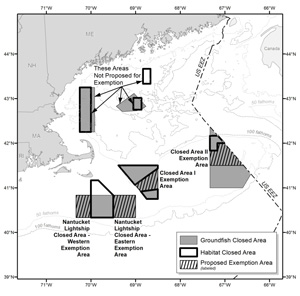
Map showing suggested areas to be re-opened after long-time closure.
Download here (Credit: NOAA)
As part of an overall effort to help fishermen adjust to new quota cuts for groundfish implemented last month, today, N.O.A.A. Fisheries announced a suggestion to open approximately 33 percent of areas currently closed to protect groundfish and habitat that have been off limits for nearly 20 years -- that is 2,925 square miles of the approximately 8,920 sq miles currently closed. The suggestion also includes protections to ensure that habitat, vulnerable groundfish stocks, and other species, such as whales and harbor porpoise, are not put at risk.
In April, based largely on advice from the New England Fishery Management Council, N.O.A.A. Fisheries announced its final management measures for the Northeast groundfish fishery, including much lower quotas for some key stocks. Those measures went into effect in May. N.O.A.A. Fisheries has been working for months to lessen the effects of these cuts on fishermen and fishing communities, including increasing quotas and approving use of various gear and fishing methods to help fishermen better target healthy groundfish and other stocks prior to today's announcement.
"We've been working with fishermen, state managers and others to find creative ways to help fishermen identify sustainable fishing opportunities this year," said John Bullard, N.O.A.A. Fisheries northeast regional administrator. "Today's action is another step in our overall effort to help transition fishing effort to healthy, more abundant fish stocks, while we work to rebuild cod and other stocks in poor condition and protect important habitats that are crucial for the overall health of our marine ecosystems."
The 3 offshore areas under consideration lie to the south and east of Cape Cod. N.O.A.A. Fisheries does not propose to reopen these areas in their entirety; specific sections will remain closed based on the Council's recommendations to protect habitat. Also, catch of stocks that are in poor condition, such as Georges Bank yellowtail and cod stocks, or are spawning, will be minimized through seasonal restrictions and the use of selective trawl and hook gear.
While these areas have been closed to groundfishing, other fishing activities have occurred in portions of these areas including lobster fishing. N.O.A.A. Fisheries also suggests to enact an arrangement negotiated between groundfish and lobster fishermen, and recommended by the Atlantic States Marine Fisheries Commission, which limits groundfishing to times of year when lobster fishing is not as prevalent to minimize the potential for conflict between gear types.
"When year-round closures were put in place, our main goal was to reduce groundfish catch. However, now that fishermen are operating under yearly catch limits, we no longer need year-round closures to control total catch but some areas still need to remain closed to protect habitat and those that we open must be opened in a responsible and sustainable way," continued Bullard.
In areas that N.O.A.A. Fisheries is proposing to reopen, the agency is proposing to require monitoring on all fishing trips to gather data on fish caught and possible interactions with whales, harbor porpoise, and other animals. Fishing vessel operators wanting access to these areas will be required to cover the cost of monitoring.
N.O.A.A. Fisheries is also proposing to keep inshore year-round closures in place. This decision is due to the poor condition of Gulf of Maine cod and haddock and concerns expressed by a number of commercial and recreational fishermen and members of the environmental community.
NOAA's mission is to understand and predict changes in the Earth's environment, from the depths of the ocean to the surface of the sun, and to conserve and manage our coastal and marine resources. Join us on Facebook, Twitter and our other social media channels.

